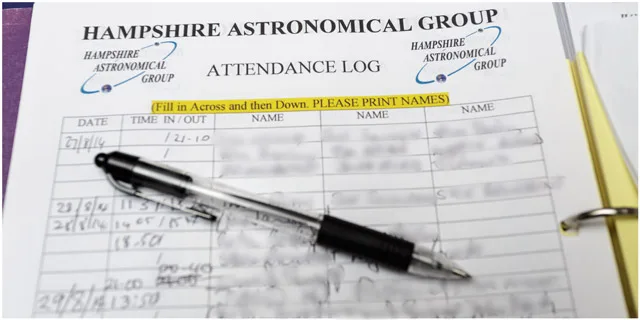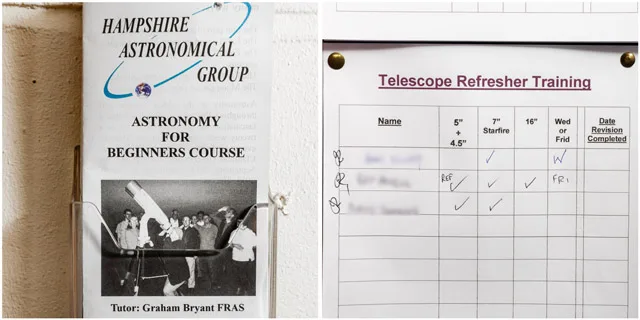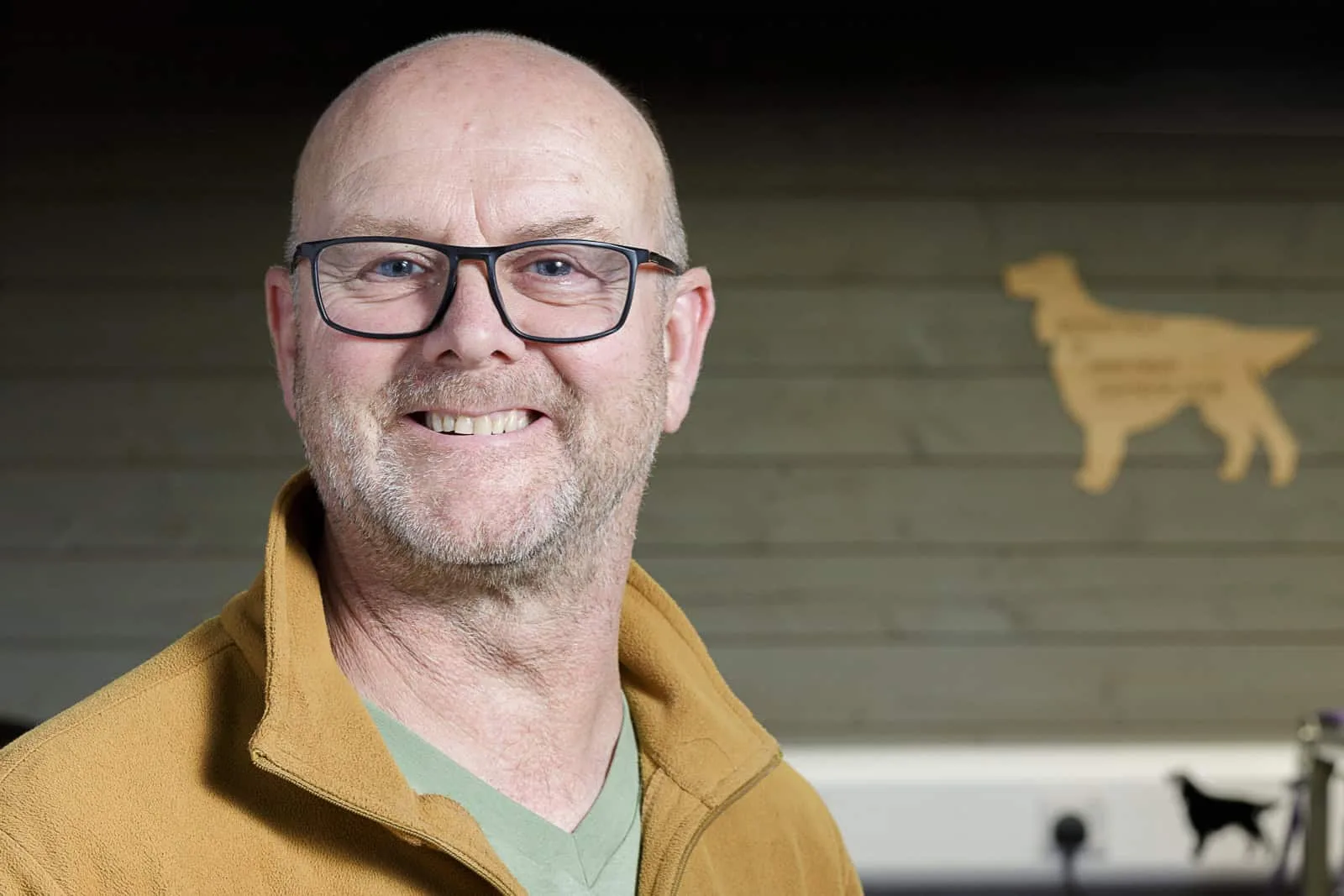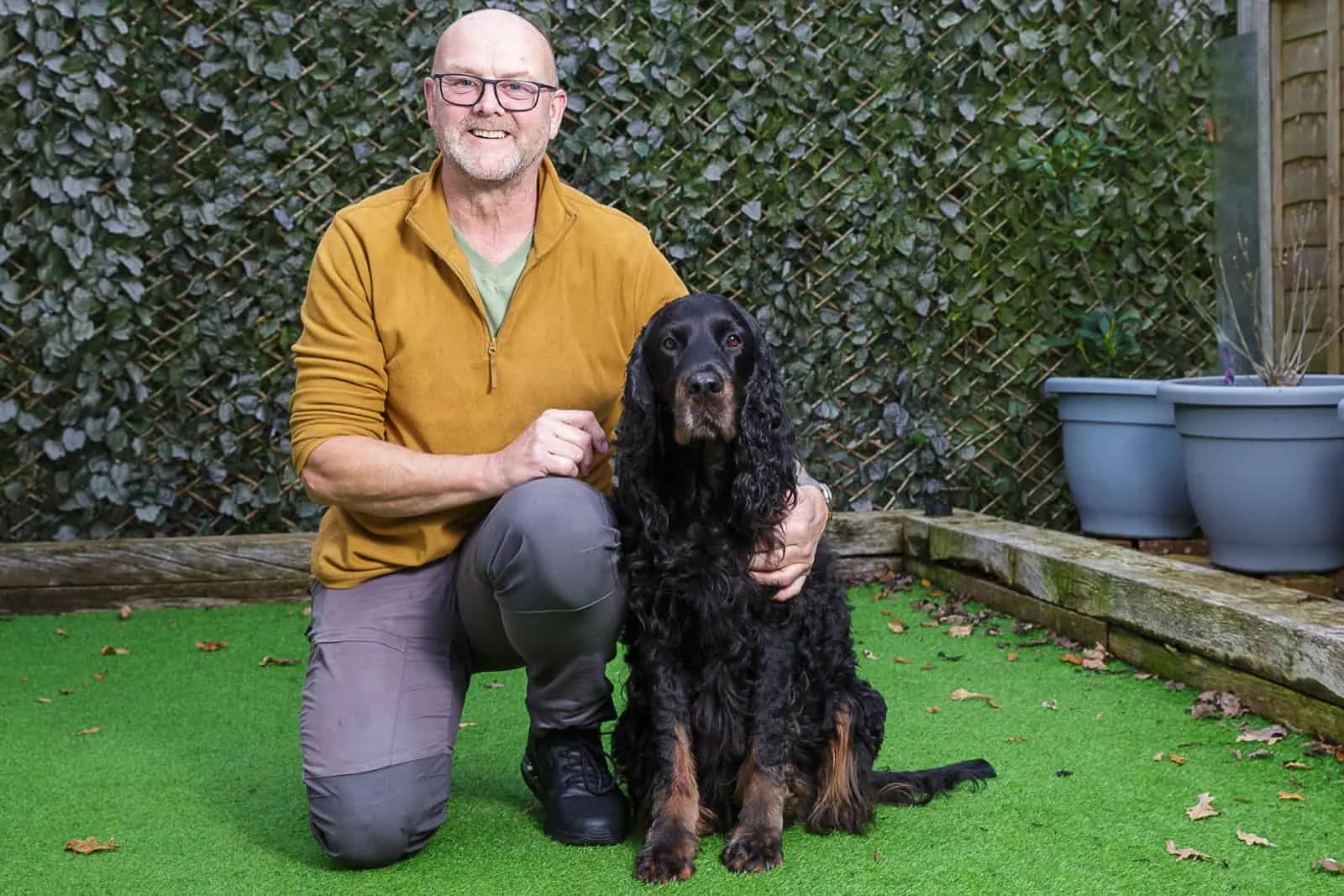In this final part of Keith’s story, we explore the challenges and highlights of being…
Astronomy – To infinity and beyond: Part One
1.
Astronomy – To infinity and beyond: Part One
From the days of watching the heavens for meteors as a young boy, through to the early days of retirement, Graham’s interest in astronomy has dominated nearly all of his free time. So much so that The Hampshire Astronomical Group is now almost his second home.

Introduction
Have you always lived in these parts?
I’ve spent the last forty odd years in this area, but I was born in West Hartlepool. I spent my childhood in East Anglia, moving to the Portsmouth area when I was eleven years old, where I completed my schooling.
Has your career path been in a singular direction or, like most of us, has it chopped and changed?
I’ve been in the NHS all my working life. I left school at eighteen and started work as a health care assistant in a local hospital in Portsmouth, before going on to complete my training. I stayed with the NHS and eventually retired, as hospital manager, two years ago. I’m fully retired from work, but even busier with all the other things that I do. My wife, Terri, says that she sees less of me now than when I was working [laughs]

Why the passion for Astronomy?
I’d always had a boyhood interest. Growing up during the sixties, the ‘space race’ was never far from the news or our minds. In my first year of senior school, by now we’d moved to Portsmouth, we were expected to take library books out on loan for the weekend. I was sitting in the classroom on a Friday afternoon and my library book was on my desk ready to take home. The headmaster walked in, has a chat with the teacher about something or another, and started to make his way out again. As he walked out, he stopped at my desk and said, “is this the book that you’re going to take home?” I said “yes,” to which he replied, “right, come with me.” Of course I assumed that I was in trouble for something or another [laughs]. Anyway, off I go into his office, expecting the worst, but it turns out that he was an amateur astronomer, and behind his desk was a big brass telescope. So we had a bit of a chat. He asked all the usual questions about what I had in mind for a career etc. General talk about science and astronomy, not quite ‘do you want to be an astronaut?’ but that sort of thing.
Then, out of nowhere, he says, “would you like to go and see Patrick Moore?” Of course I said yes. He was quite a celebrity at the time because of all the interest in space and everything. So the headmaster telephoned there and then to arrange a meeting. Patrick answered the telephone, his number was freely available in the telephone directory, and the headmaster made an appointment.

Would you like to go and see Patrick Moore?

I was blown away of course. But, as an eleven year old, I had no way of getting to Selsey, where Patrick lived, so my uncle took me. I had a wonderful time and it was really that experience that cemented my lifelong interest in astronomy. What’s amazing is that talking to other people, both professional and amateur astronomers, very often, their stories are similar.
Were there clubs and societies at school?
Not until I went to the Technical High School, which is now the Portsmouth City Boys School. They had an astronomy club, with an observatory on the top of the school building. We would meet up at lunchtimes and do some solar observing. After school, they would set up telescopes on the playing fields for night time observations as well.

Around the same time, I got involved with the Portsmouth Astronomical Society. A lot of those members had also been to the ‘Tech’, so we knew each other, and we used to have ‘meteor observing’ weekends. There was never enough money for telescopes or our own equipment. But, for meteor observing, you don’t need anything fancy, you can do the observing sat in a deckchair making written recordings. As a result of that, I developed quite a lot of interest in meteors.

Waterlooville, August 1962 [Credit: D Pepper]

Waterlooville August 1962. [Credit: D Pepper]
I purchased my first small telescope which was bought from a chemists for something like 52s 6d.
I made my first astronomical telescope when I was at school. Because it was a technical school, we had metalwork and woodwork labs, which were used to teach us the trades. I built a telescope as a metalwork project. It never worked, [laughs] but I had a go. I ended up buying a fully working one, second hand, when I first started work, so my first serious telescope was bought during my late teens.
Editor: Younger readers may have to check google for a currency conversion :-[]
Has your hobby dictated where you live?
Well, the best locations are always going to be rural, because of the light pollution in the towns and cities. It was definitely a desire to have a good location, but it was some time before my wife and I could afford to move away from a built up area. Then, in the mid 1980s, we had the opportunity to move, and we relocated to Rowlands Castle (slightly north of Havant, Hampshire). It was there that I built my first observatory in the back garden.
The wife and I parted company in the mid 1990s, so I had to find a new home for the dome and decided to put it in the grounds of the Clanfield Observatory. I lived close by, in Clanfield village, until I met Terri in the late 1990s, and moved to where we are now.

It tailed off a little when I first got married, which is inevitable with a change of priorities, especially when children come along. I was working full on at that time, to pay the bills, so there wasn’t a lot of spare ‘me’ to go around. Once things settled down, after a couple of years gap, I picked astronomy back up again. I met up with some of my former colleagues, but then the Portsmouth Astronomical Society kind of fizzled out and I joined the Hampshire Astronomical Group (HAG).

When did you join HAG?
That was in the late 1980s and I’ve been with them for some twenty-five years or so now.
HAG History
The Hampshire Astronomical Group [HAG] has been going since the 1960s?
Yes, as you say they were formed in 1960, and we have a spot on the Clanfield / Horndean border and just inside, what has now been designated, the South Downs Park.

No, the first observatory that the group built was at Crookhorn, on a piece of land that was part of a dairy farm. The farm was owned by a local family, the Gauntlet brothers, who were well known in this area for running the, now (I think) defunct, Gauntlet Dairies.
There was an old gun emplacement left over from WWII, which, of course, being round, was ideal for putting a dome on. This first dome had a twelve inch telescope which, for the time, was a fair size. With little or no funds, everything was all put together piecemeal, using whatever could be scrounged. Unfortunately, almost as soon the build was completed, the farmer told them that he had sold the farm to Portsmouth City Council for housing. The land eventually became, what is now, the Crookhorn housing estate.

No doubt feeling a little guilty, the farmer offered them a location on his brother’s farm, at the other end of Portsdown Hill. This farm also had a WWII gun emplacement, with the addition of a large concrete bunker. HAG used the bunker as a club room, and built the observatory with concrete blocks outside. They moved everything, lock, stock and barrel, to this new location, and stayed there until the late 1980s.
During the late 1960s the observations were starting to suffer with the surrounding light pollution, so the Group was always on the look out for an alternative location. In 1972 they found, what eventually became, the Clanfield Observatory site. The land is still owned by the Portsmouth Water Company, but the group was granted use for a peppercorn rent, which still stands today. The big telescope was built at Clanfield between 1972 and 1978. At the time, there was no such thing as the luxury of power, so everything was done manually. Mixing concrete, drilling metal and wood, everything was done by hand. We have one of our members, Ken Palmer, an amateur filmmaker, who captured a lot of the men at work on an old fashioned super eight film camera. Everyone moves around at varying speeds, it’s all a bit flickery, and there are those scratchy lines running up and down the film, but it’s a wonderful piece of archive footage of what it took to build that telescope.
REF :The third HAA battery on Portsdown was located at Moorelands, Crookhorn.
This site was completely leveled and rebuilt on during the early 1970s and not a trace of it remains today. It housed 4 x 3.7 inch guns.
This site was completely leveled and rebuilt on during the early 1970s and not a trace of it remains today. It housed 4 x 3.7 inch guns.

[Photo credit: Rob Hunt – Portsdown Tunnels]
The telescope was finally commissioned by Patrick Moore in 1978. So, from 1978 until around 1987/1988, we ran two fully operational observatories. It got a bit expensive, as you can imagine, so we consolidated all the equipment and moved everything up to Clanfield. It’s a much darker location, on a hill and out of the way, with only one road to it. So we don’t have much in the way of passing traffic.
Potted history of the Clanfield site.
1982 Five inch Cook Refractor built in situ
1989 to 1992 The clubroom was built
1992 The sixteen inch reflector came on site.
1995 – 1996 The twelve inch reflector [owned by Graham] added.
2006 – 2007 Seven inch refractor added.
2014 The 24 inch refractor replaced (due to open October 2014)
It’s now the largest amateur observatory in
the UK, with the stress being on ‘amateur’

What’s the difference between amateur and professional astronomers?
Everything on site has been built or added by ourselves. We’re all volunteers, and none of us get paid. Most large observatories are funded by professional organisations such as universities. Those will be massive, because they are staffed and funded to support undergraduate and post graduate studies etc.
How many members does HAG have?
We have 180 at the moment. Resources obviously dictate what is practical, and the numbers have varied, depending on what facilities there have been at any given time in our history. The amount of interest in the group is phenomenal at the moment. We have a waiting list of around sixty people, which at the rate that we are getting them in, is something like a three-year wait. That can be a bit uncomfortable for me because I run the astronomy course at the site. Naturally, when people complete the course, they ask to join the group.


How is the group funded?
The subscriptions from members, £50 per year, cover the basic running of the site. The usual things like insurance, phone and electricity bill, rent and rates etc. It sounds a lot, but when you break it down, that equates to around 12 pence a day. As well as telescopes for night time viewing, we also have telescopes for viewing the sun. If you don’t want to visit the site in person, membership entitles you to download images from the meteor cameras in the comfort of your own home. So we have 24hr access for, basically, 92 pence a week.
The University also gives us a donation each year, in return for supporting and mentoring the physics and maths students. Each student has six accompanied visits to the site a year. In addition, we levy a small charge for any private visits, open evenings, or other public events.

Is there a rota for members’ access?
We have a few members dotted around the world, so, clearly, they wouldn’t want physical access to the telescopes themselves. Other members could be considered armchair astronomers, who just like to be involved with whatever is going on. They will attend lectures and talks, help out when needed, but don’t spend a great deal of time observing. I would think that there is a core of around thirty people who are more active when it comes to observing. Within that group, it can be further divided into those who will only observe when the weather conditions are favourable…….. This year I’ve had very little time observing, because I’m up there all day involved in the building work. By the time I’ve finished, I have very little energy left for anything. Hopefully, that will change when the new telescope has been settled in.
In fact, because our numbers have increased, we have just decided to start a telescope booking system. That should avoid any instances of a telescope, or other equipment, being over subscribed. It’s very rare that it happens, and it’s usually settled by a gentleman’s agreement, but it would be good to avoid, if possible.

Would you say that the group specialises in any particular areas?
No, it’s really eclectic. The interests are right across the board.
University Links

Do you have any ties with Portsmouth University?
We’ve had links for a long time, mostly for undergraduate mathematics and physics students. Mathematics students will often come along and spend some time with us for their final year project. This can be anything that they want, as long as it has a mathematical component at Bachelor of Science level. Some of the students like to do astronomy because of the opportunity to explore the maths, and we’ve made links with the University through putting together a mentoring program to support them.

We’ll take the students through using the equipment, and they will take the data from their observations back to the University, to crunch the numbers afterwards. That’s been going on for several years now, and I have to say that it’s a real pleasure to work with them. At that level, they don’t have to be doing cutting edge science, but it must exercise their particular degree subject.

[Credit: Jonathan Harrie former student of Portsmouth University]
We were one of the first amateur organisations in the UK to have a program detecting planets around other stars, which are called Exo-planets. We had students with us looking at these target stars, and watching for incredibly faint dips in the light from them. We capture lots of images, every couple of minutes or so, and make comparisons with other stars. If the light level dips in both, it’s probably just a cloud gone passing in front of the lens [laughs]. But you’re dealing with hundredths of an order of magnitude, so it’s a tough bit of work. One of the things that we can do with that information is we can start to see ‘limb darkening’ on that particular star. This is quite easy to see on the Sun, because of its proximity to us. But to be able to see this effect on a star, which is hundreds of light years away, is incredible. The students do all of the maths associated with this phenomenon, as part of their project.
For more details see HAG Science Projects (link at end of article)
REF: Limb Darkening
Limb darkening is an optical effect seen in stars (including the Sun), where the centre part of the disk appears brighter than the edge or limb of the image.
http://en.wikipedia.org/wiki/Limb_darkening
Limb darkening is an optical effect seen in stars (including the Sun), where the centre part of the disk appears brighter than the edge or limb of the image.
http://en.wikipedia.org/wiki/Limb_darkening

I believe that you also cater for younger students?
Indeed, we cater for groups such as The Boy Scouts, Cubs, Girl Guides, that sort of thing. We tend not to have any children below six or seven years old, because of the limited attention span at that age. They can also get cold and bored quite quickly. The children that are the most interested, the ones that ask the toughest questions, are about nine, ten, or eleven years old. They will stretch you to the very limit of your knowledge. What amazes me is that they know just enough about the subject to ask the right question. Whereas, an adult who doesn’t have any, or very limited background knowledge, will only ask a surface level question. Whenever we have a member volunteer to show groups of children around the site, they often ask for any advice on what to expect. The answer is, adults, no problem, but be very afraid when a ten year old puts his hand up. [laughs]
It’s now the largest amateur observatory in the UK
What would you say the ratio of male to female interest is?
For those showing interest in Astronomy I would say that it’s fairly well balanced. Slightly more men, probably, as you would expect, but at the young children level, it’s not far off 50:50.
We have a group of ladies called the ‘Red Hatters’, who, as the name would suggest, all wear red hats. Most of them are retired and, being a little older, they all remember the sky as children, when there wasn’t so much light pollution. Seeing the stars, in all their glory, is a big nostalgia trip for them. It’s not exactly the same, of course, but because of the observatory’s location, it’s not far off.

[Photo credit: Dmgerman -Licensed under CC BY-SA 2.0]
REF: Red Hat Society
The Red Hat Society (RHS) is a social organisation originally founded in 1998 in the United States for women age 50 and beyond, but now open to women of all ages. As of 2011, there were over 40,000 chapters in the United States and 30 other countries.
The Red Hat Society (RHS) is a social organisation originally founded in 1998 in the United States for women age 50 and beyond, but now open to women of all ages. As of 2011, there were over 40,000 chapters in the United States and 30 other countries.
Do you have a background in mathematics?
Not at all, I leave that to the experts. I’ve always said to the students, when they come up to the site, “I’ll teach you how to use the telescopes, how to do the observing, all the safety measures, the hands-on research tips and tricks, but when it comes to the calculations, you’re on your own.” [laughs]. I do encourage them to write up their findings and rigorously record the details of any adjustments they had to make. To also keep a note of any problems that they may have encountered in collecting the data. It can all affect the end result, so the more information they have to hand, the greater the chance of their observations being qualified or reinforced.

Have any of your students found fame and fortune?
[Laughs] I’m not sure about that. Although I did have one student a little while ago, when I was looking at pulsating stars, who was investigating the thermodynamics and pulsing effects. As a star heats up, it will expand. When it expands, it cools off, because of a larger surface area, and it contracts again. There was some formula around in the existing literature, which he used as the basis for his calculations, but complained that he couldn’t get it all to tally. After some head scratching, he took his work along to a PhD maths student to see where he was going wrong. After his work had been double and treble checked, they realised that the published source formula was wrong. This was an undergraduate student, picking up a published paper from a highly regarded source, and assuming that it was his own work that was wrong. When it was finally cross-referenced with other sources, and the calculations amended, he was awarded a first class degree for his work.
Next time we get to look, in some detail, at the equipment that the HAG groups uses, and some of the software that helps get the very best astronomy pictures.
Web Links and References of interest
HAG: Hampshire Astronomical Group
Web: http://www.hantsastro.org.uk/
Contact details: http://www.hantsastro.org.uk/contact/index.php
HAG Science Projects
http://www.hantsastro.org.uk/projects/index.php
http://www.hantsastro.org.uk/projects/epsilonaurigae/index.php
http://www.hantsastro.org.uk/projects/exoplanets/index.php
National astronomy meetings
http://www.nam2014.org/
Night Sky and Astro Photography Tutorials
https://www.lightstalking.com/night-sky-photography/



